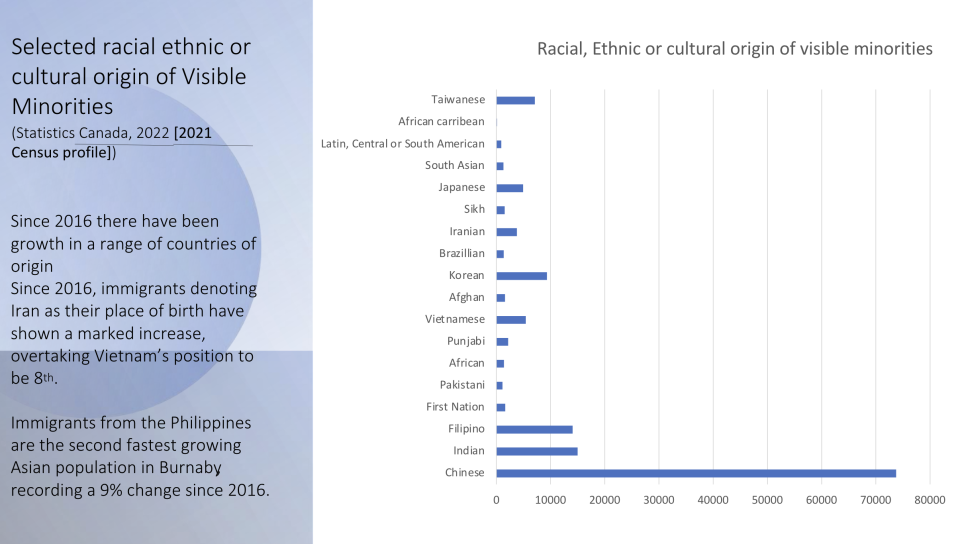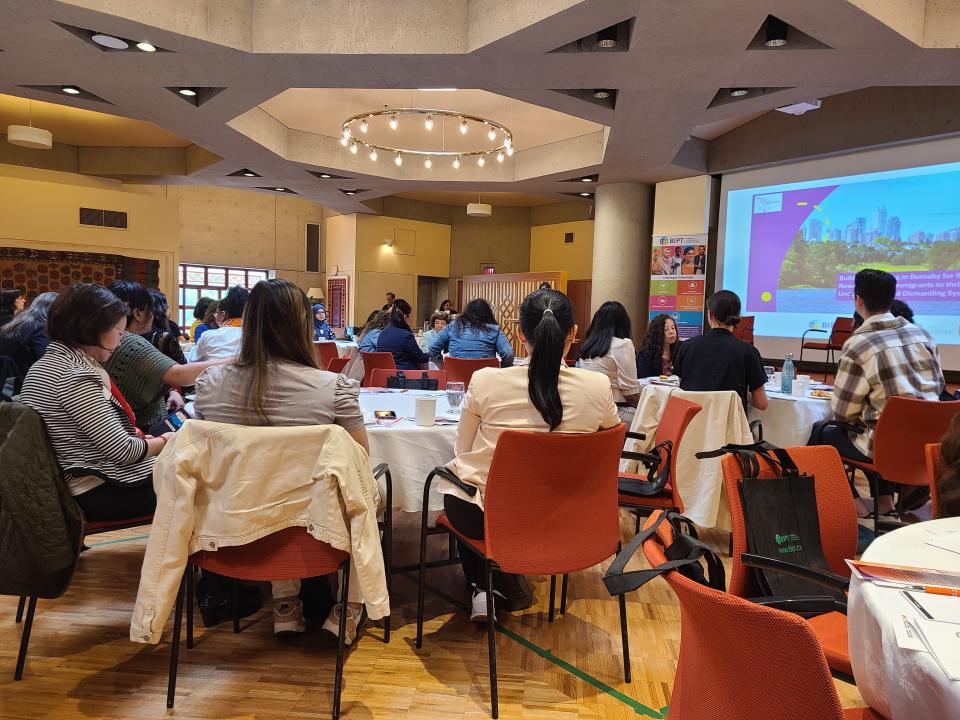City embraces anti-racism research, commits to acting on its findings
Researcher and SFU professor June Francis presented the results of a two-year study on systemic racism in Burnaby at an event organized by Burnaby Together Coalition Against Racism and Hate at the Ismaili Centre in Burnaby on May 23. Francis and her colleague Kristina Henriksen conducted the research, and the findings were published in an 86-page report titled Building Belonging in Burnaby for Racialized Newcomers and Immigrants to thrive – Understanding and Dismantling Systemic Racism.
More than 100 people attended the event, including two city councillors, Coun. Maita Santiago and Coun. Alison Gu. Both councillors are also members of the city’s Social Planning Committee, which Gu chairs.
The project scope included reviewing the latest academic research, benchmarks, leading practices, and policies. It also utilized census and other survey data and reviewed the City of Burnaby’s committee and council recordings, transcripts, and minutes. In addition, researchers conducted more than 50 meetings and interviews and hosted more than 100 focus groups, workshops, labs, and listening sessions.

The research results spanned a wide range of issues affecting racialized people in Burnaby, such as unintended biases in the built environment and the devaluation of racialized newcomers’ credentials. For example, the study found that immigrants are far more often overqualified for their jobs than nonimmigrants.
“The percentage of overqualified immigrants in the labour force in British Columbia is 24.8% in 2016 compared to 12.2% for nonimmigrants,” the report said. The problem seems to affect racialized immigrants disproportionately compared with immigrants from European countries.
“Racialized immigrant groups show alarmingly high rates of overqualification from Southeast Asia (53.6%). Southern Asia (38%), Caribbean and Bermuda (28.8%), Sub-Saharan Africa (28.7%) among other groups,” the report said.
The report also covers biases in the built environment, such as in public spaces, recreational facilities, and even in the sense of safety racialized people feel when walking down the street. In addition, chapters are dedicated to health and well-being and the school system. The researchers also scrutinized Burnaby’s 2050 official community plan.
“An evaluation of the report to council that was presented in February 2023 reveals that there were no references to racial equity and no specific strategic considerations given to how this engagement and subsequent processes would be viewed and considered through antiracism and racial equity lenses,” the research report said.

Where do the roadmaps lead?
During the city’s Social Planning Committee meeting on Wednesday, May 22, social planner Kai Okazaki presented a new framework for antiracism in Burnaby. This was one day before Francis presented the results of her research at the Burnaby Together event.
The framework is summarized in a 20-page report, available to the public online, which considers the results and recommendations of two studies. The first is a 2022 study by researcher Sangeeta Subramanian about the city’s existing efforts in combating antiracism and gaps in those efforts. The second is the research by Francis and Henriksen.
The framework’s stated goal in the report is to “Model, signal and lead the way to an anti-racist Burnaby through clear, publicly communicated commitments on Burnaby’s intentions and standards that take a decisive ‘stand’ against racism.”
It also stated three broad commitments, which should translate into specific actions the city intends to take.
Value #1: Reflection – We commit to appreciating what’s been shared and a willingness to look deeply, to learn, and to both hear the truth and tell the truth about racism in Burnaby.
Value #2: Accountability – We commit to taking responsibility for anti-racist work in big and small ways, as a municipality.
Value #3: Transformation – We commit to supporting the necessary changes that embed antiracism in our processes, structures, practices, and guidelines and our people.

The report also outlines 29 action items in four key areas: leadership and governance, learning and training, belonging and inclusion, and engagement and evaluation. Seventeen of these are items for future consideration.
Some actions are already underway, such as committing to increasing the representation of Indigenous, Black, and people of colour in the city’s committees and advisory bodies. The city is also undertaking an audit, review, and update of existing policies, procedures, and bylaws with an anti-racist lens. It is also investing in anti-racism training for all city staff.
According to Okazaki’s presentation, the city’s anti-racism efforts began in earnest in 2020 during the pandemic after the city witnessed an increase in hate crimes against people of Asian descent. In 2022, the city provided funding for the two anti-racism projects and created a subcommittee for anti-racism.
As for public engagement on the framework, Okazaki said the framework is only a starting point.
“Should council move further along with developing an implementation plan, we’ll look at each action item carefully. If there are emerging applications of ways that can encourage public participation, we will ensure that we can offer those opportunities.”
Accountability, policy and data
However, speaking with the Beacon, Francis said that the city’s frameworks and promises are all well and good, but Burnaby needs to be held accountable.
“They need to be more accountable to their citizens. They need to adopt an anti-racism framework that is robust and accountable, that actually leads to change, and they can measure impact,” she said. “I think that it requires policies with real targets. The city, as an example, cannot hope to be anti-racist if it is racist. If all the senior people are from one group, then they can’t do the job.”
Entrenched structures of inequality and colonialism are often enforced by various racialized groups that work against each other. According to Francis, one of the most insidious ways that systemic racism functions is by pitting different racialized groups against each other.

“It’s a scarcity thing. You have so many resources, and you give one group a little bit or a few more jobs, or whatever the advantage is. That’s how colonization works,” Francis said. For this reason, Francis said it is essential to highlight the experiences of the most excluded groups suffering under the weight of the dominant group and other groups in society.
Francis also spoke about the importance of collecting data, creating policies, and putting anti-racism into policy, as people in power are rarely motivated to share it. Collecting disaggregated data is an integral part of the process. Otherwise, systemic inequities remain hidden and persist.
“One of the things is to have governance structures that are not part of the bureaucratic governance structures and to disrupt the governance structures that are there. So you have a body whose goal is to evaluate how to change old practices to help pilot these things through the organization,” she said. “Unless it has real teeth that way, it won’t happen.”
Lubna El Elaimy, Local Journalism Initiative Reporter, Burnaby Beacon


